#bulgarian pottery
Text
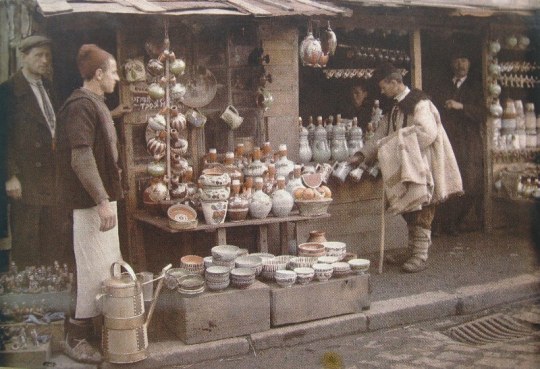
Troyan Pottery
1931
National Geographic (found and described by Penka Petrova-Goliyska, former curator at the Troyan Museum of Crafts and Applied Arts)
56 notes
·
View notes
Text
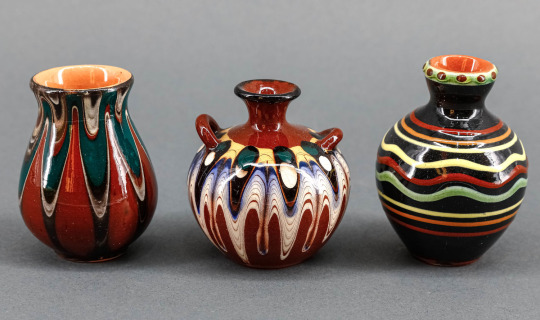
Bulgaria, Trojan, c. mid-twentieth century.
Ceramics, angobami painting (flyandrovka), glaze.
The presented items belong to the Bulgarian pottery tradition, the center of which is the city of Trojan. Over the past centuries, the masters have developed their recognizable style, which has almost become a symbol of the region and the country as a whole.
Antikvnevremeni
17 notes
·
View notes
Text
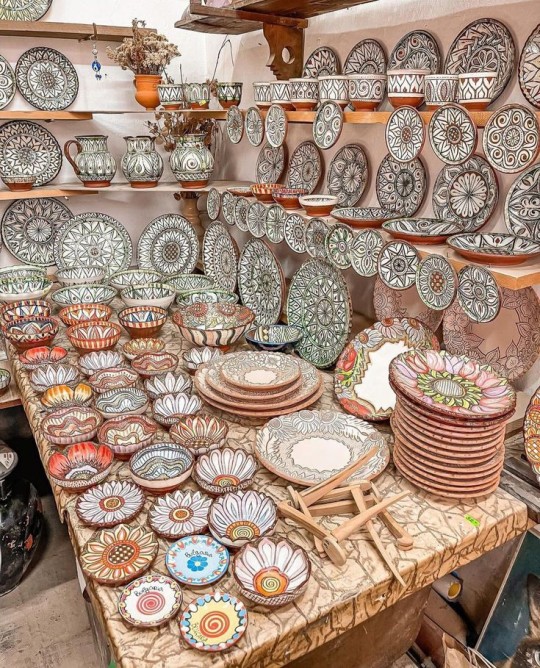
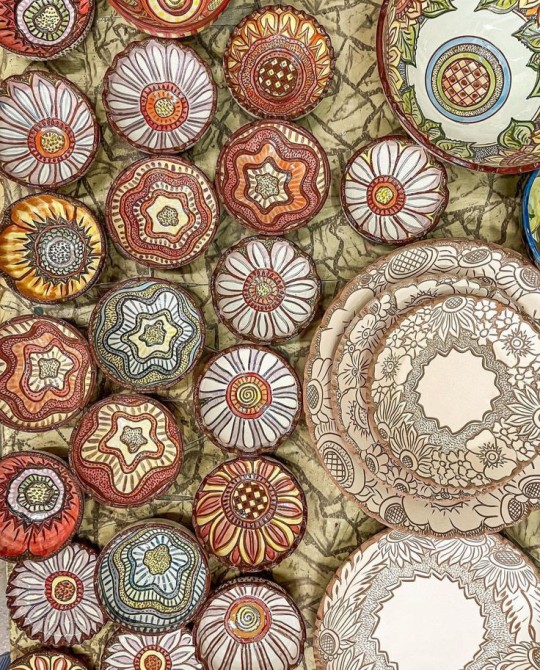


Sgraffito-style "royal" pottery at the marketplace in Veliko Tarnovo, Bulgaria. Sgraffito was a popular technique for the manufacturing of ceramics in the Second Bulgarian Tsardom (12th-14th c.), however abandoned during the Ottoman yoke. It was revived by 20th century artisans after archeological research unearthed remnants of medieval pottery inside Tsarevets fortress, which helped rediscover the authenic colors and patterns used once.
"Царска" сграфито керамика от Самоводската чаршия, Велико Търново. Техниката сграфито е популярна по времето на Второто българско царство (XII-XIVв.), но е забравена след падането под османско иго. Преоткрита е от майстори-грънчари през XX век, когато при разкопки на крепостта Царевец са намерени останки от средновековни чаши и чинии. По тях съвременните майстори се ориентират за орнаментите и багрите, използвани някога.
Photos by Jovana Kvrzić
96 notes
·
View notes
Text
A pottery shard and a glass ornament shard.

The one to the left is from a traditional Bulgarian ceramic piece I'm certain.
4 notes
·
View notes
Note
I need to hear about your instagram crush 👀 🍿
oh my god jae I do not think you know what you’ve just opened by asking this of me😫are you ready? I could talk about this boy for HOURS!
let me take you on a Journey™️
so some things you need to know about me first:
1. my obsession with pretty boys (and people in general) extends far beyond me crying about them on tumblr (which I do quite frequently). ergo pretty boys tend to pop up on my instagram feed as fashion influencers, dancers, singers, pottery artists (this is a very large niche apparently?) and most frequently: gym goers.
2. now another thing you need to know about me: i DO NOT gym. beyond not being even remotely interested in it, I also have a myriad of joint problems (shoutout jana (@disappearsreappears ) for being metaphorical cane-babes together) and therefore going to the gym and doing cool gym stuff is not really an option for me. so naturally I don’t actively engage in gym content for gym related purposes, in any aspect of my life
3. but nonetheless because I love pretty boys, and THEY love gym, I get a lot of gym content on my Instagram.
4. another thing you need to know: I spend a clinically distressing amount of time on instagram. like if you think I waste away on tumblr, instags is at least twice as bad :/
5. that means I get through A Lot of content in one day. but, while I’m pretty liberal about what content I watch and engage in, I’m quite strict about who I follow. instagram is a nightmare of suggestions and recommendations in the home feed, the explore page, and the reels so the small amount of curation I actually can do, I keep under strict lockdown.
6. therefore despite having lots of fun seeing pretty boys in my reels and smiling ridiculously at the screen as they attempt to hit personal gym records for weird shit like russian deadlifts and bulgarian split squats, I don’t just follow every pretty human i see.
7. in fact, unless I really really like your videos (/content) and they surpass my usual serotonin boost I don’t care how many times you come up in my feed I probably won’t follow you.
8. one more thing about me: I have two instagram accounts — one I created in 2013 and has been on private and will continue to be on private since then (it’s my main Instagram where I follow all my people from). and the other I started in 2021 to post more of my chaos things > that one is public and full of nonsense and I don’t follow anyone from there cause I use it purely as an memory book of sorts (it’s linked on all my tumbles so I’m not linking here but the important thing is that it’s public so anyone can see what I post < that’s important for later)
okay onto my Instagram crush and (self proclaimed) love of my life 😫
scott ho (aka @/scottoho) popped up in my reels in January this year (I think it was jan it may have been the undefined time between dec and jan but I’m like seventy five percent sure it was jan) with this sinful video (I’d like to defend myself at this point and say not all, in fact almost none of, the gym related videos that pop up in my feed are this…slutty… though I’m certainly not complaining). and I was like oh my god he’s preetttyyyyyy.
but I didn’t follow him (see above) I just liked the reel and moved on. but (for those who managed to avoid the instags hellscape) interacting once with something on there will most definitely prompt an entire slew of that account’s (and other accounts like it) content. so over the next few days I got a couple more scott related gym videos.
usually I take about a month or more to follow someone if I keep seeing their content and like it. it took me two days to follow him😫I saw an arm workout, a leg workout, and my absolute weakness, a back workout
I was SOLD!
pretty boy ✅
shows us pretty back muscles✅
and one of his posts had him looking gorgeous in a baby blue sweater at a fucking art gallery✅ (lord I’m still unsure how I survive him)
now yes he was a pretty boy I followed but he wasn’t, at this stage my instagram crush. no, not yet. a couple weeks and many videos go by where I’m happy to see him on my feed and enjoy his content
15 jan (I know the date cause I sent his vid to a friend I was crying about it to) rolls around and a leg workout pops up. INSTANT LOVE. I don’t know what the fuck was in that video but I was GONNNEEEE about it. literally just tumbled head first into obsession
and that marks the day I started looking forward to see his content on my feed (clinically down bad at this point)
he then posted this video dancing to that adorable “sure thing” trend (“if you be the cash I’ll be the rubber band etc etc.”) and I melted straight into the earth’s core and immediately saved that video to my instags. I also went through the effort of reposting that video on my public instagram account purely so he would be able to see it! and he did! and he liked my story and I cried about THAT for about eighty five days
fast forward to me screaming shaking crying throwing up about him on a daily basis and telling my friend in LA she has to pack him in her suitcase when she’s coming back because I. NEED. HIM!!!! (she said she would but she also has my soju glasses and frankly those are still more important no matter how much I love him)
AND THEN: (cause no this is not over — I told you you opened the doors to hell)
he posted this video showing what he looked like before his workout (muscles less defined, skin not as flushed, so so gorgeous) and after (muscles more defined, skin a pretty pink, the most beautiful ever!). and the caption for the video was “before the pump and after the pump // can you tell the difference?”
and me (who is delusional but also forward as hell) commented: “pretty before, pretty after ✨” which he then responded to with “ur pretty during”.
JAE I DIED????!!!!!! HOW DARE HE DO THAT TO ME????? I FUCKING PASSED OUT!!!!!!
(and yes I know he was just being smooth with it and he defs has zero idea what I look like and he responds to lots of comments etc. etc. but love is delusional and I’m obsessed so I will continue to live in fantasy world)
anyway that comment (and his reply) got some attention (I’m still getting notifications about it which is extremely annoying does anyone know how to stop them?).
alas after this he posted a video where he and another influencer did a skit where they pretended to bump into each other by accident. it was very cute and I cried about it because the love of my life is in love with someone else what am I gonna do I can’t believe this😔😔😔😔I was in heartbreak central.
BUT after that I found out he played basketball (which is my favourite sport to watch) and I was back to WANTING TO MARRY HIM!
and then he posted a video showing his overnight oats recipe which I then reposted on stories with the caption “two meals in this video” which he saw and liked (when you’re in love those little instagram floating hearts really be giving you all the chemicals you need) (really at this point I’m just surprised my mother hasn’t called asking why I’m publicly thirsting over someone?)
anyway, I’m stocked up nice and full on my daily scott serotonin boost when a couple days later he posts a shoulder work out and I reposted that on my stories
(guys please understand I don’t follow him from my public account I really am so fucked I go through a whole process for reposting on the off chance he’ll see it UGH)
with the caption, “my only goal this year is to be so delusional I can pretend I’ll bump into @/scottoho on the street even though we live 10’s of 1000’s of km’s away from each other // it’s working btdubs (I’m so delusional)” which he REPLIED TO with: “maybe if you come to LA” and suddenly I had a notification from him in my direct messages 😫😫😫😫😫please I could not contain myself I think I crashed the metaphorical car . I was i n c o h e r e n t about it !!!
anyway after not recovering from that at all I am fully in the thirsting business when it comes to scott and I don’t see myself stopping until I get ignored because he got so popular he just cannot realistically reply to everyone (please that’s nightmare day😭😫) < can y’all tell I like attention?
ps. he posted the cutest ramble on his stories yesterday I watched it like seventeen times I can’t believe stories disappear I need to eat this man!
okay thank you for letting me take you on this journey. I hope you can understand I’m really going through it with him at the moment (because I’m fucking on crack and also delusional) and there will definitely be more tumblr posts where I cry about him (I can’t say I’m sorry)
mwah! sending love jae :) <3
#jae things#lh things#I don’t remember which tag I use for you jae😫#ciara’s convos#my instgram crush <3#ciara in love (delusional)
5 notes
·
View notes
Text
More 80s Titans brainrot, cause why not. This time with Tara and Rachel again.
Rachel Roth is of course, is a very Jewish name. Rachel literally means ewe in Hebrew, just like Arella means messenger of God, or more literally, an angel. So sheep and an angel. Very Christ-y.
https://en.wikipedia.org/wiki/Roth_(surname)
Roth has Germanic origins, but apparently it was a popular surname adopted by (Ashkenazi) Jews in Germanic countries. It means the following:
The spilling of blood from the warrior class of ancient Germanic soldiers;
Ethnic name for an Anglo-Saxon, derived from rot (meaning "red" before the 7th century), referencing red-haired people;
Topographical name, derived from rod (meaning "wood"), meaning a dweller in such a location;
Derivative from hroth (from the Proto-Germanic word for "fame"; related to hrod);
Local name for 18th-century Ashkenazi refugees to Germany;
Derivative from roe in the ancient Danish language to signify (of) a king;
Of the red colour of clay, as in pottery (German).
Bunch of possible associations. I'm guessing most of the associations with the color red has to do with her earlier relationship with Wally, not the later associations her character has.
I think the initial vibe Wolfman-Perez were going for was the inverted Christ imagery, as a sacrifical sheep soaked in blood, for Trigon’s return. Obviously Joey’s hero name, Jericho, also ironically teases he will be killed by his own father’s hand, with Slade being shown as a Biblical Pagan King, punished to kill his own Jewish son.
For Tara,
https://en.wikipedia.org/wiki/Tara_(given_name)
Irish Gaelic: refers to the Hill of Tara, or Teamhair na Rí, the legendary seat of the High King of Ireland
In Serbia the name is often associated with the mountain of Tara and national park in Serbia and river Tara in Montenegro and Bosnia and Herzegovina
Sanskrit, Hindi, Urdu, Nepali, Marathi, Persian, Punjabi, Kurdish, Tamil, Bengali, Telugu, Sinhalese: "Star"
Obviously Tara is chosen because it is similar to Terra, but it is interesting it refers to high places in both Irish Gaelic and Serbian, though Serbian Mountain of Tara’s name is apparently based off an Illyrian tribe that lived there (which are considered to be ancestors of Albanians in Balkans, not really a Slavic connection). It is more likely that Irish Gaelic connection is more important, since Brion also comes from Gaelic word for Hill:
https://en.wikipedia.org/wiki/Brian
It is possible that the name is derived from an Old Celtic word meaning "high" or "noble".[1] For example, the element bre means "hill"; which could be transferred to mean "eminence" or "exalted one"
There isn’t much to discuss about the name Markov, though. It comes from Mark, and -ov is just a suffix more or less meaning “sons of x”. As tamaranorbust made clear in her Terra retrospective, this comes from Georgi Markov, Bulgarian dissident writer assasinated by the Bulgarian Secret Service and the KGB :
https://en.wikipedia.org/wiki/Georgi_Markov
As for the surname itself, it is mostly common in Russia and Bulgaria, and not really common other Slavic countries, most notably, not Czechia or Slovakia (though the surname still exists there apparently), which serve as the initial basis for Markovia. No wonder other DC writers took Brad Meltzer by moving Markovia way further east geographically.
Another thing to note, apparently there are some cases where the Markov surname isn’t given the feminine form, Markova:
https://en.wikipedia.org/wiki/Margaret_Markov
Though the Czech spelling apparently would be Marková:
https://en.wikipedia.org/wiki/Zuzana_Markov%C3%A1_(soprano)
Another thing to note about Meltzer, obviously he went the retcon of Brion meaning Superman in Markovian language, but I don’t know if the name Tara was pun Kara’s name (which also doesn’t come from Turkic Kara, but Latin, Gaelic or Greek Cara, which mean similar but different things), or perhaps some cheeky reference to both Laura (Madame Rouge) and/or Rita. I assume both are in effect.
2 notes
·
View notes
Photo

Devingrad Tracing Centuries of Civilization
Origin and Evolution
Devingrad, also known as “Momina Krepost,” lies east of Tsaravets, its name evolving from ancient Thracian origins through Byzantium to its present-day nomenclature under Ottoman rule. Through meticulous research, the mist of time surrounding this ancient site has begun to clear, revealing a rich tapestry of civilization dating back to the end of the Bronze Age and the dawn of the Iron Age around 1300 B.C.
Thracian Heritage
Early evidence, including rudimentary fences and structures, offers glimpses into ancient habitation patterns, with artifacts from hunting, cooking, and pottery production dating back to the Iron Age. The zenith of Thracian society around 500-400 B.C. is marked by strong cultural ties to Greek civilization, evidenced by the widespread use of classic Greek amphorae.
Byzantine Connections
The Byzantine era leaves its mark on Devingrad through the remains of fortress walls, basilicas, and domestic architecture reminiscent of the ancient city of Sikidava. Destroyed around 700 A.D., Sikidava’s influence persisted into the early 9th century A.D., coinciding with the spread of the First Bulgarian Kingdom as evidenced by archaeological findings Private Turkey Tours.
Rise to Prominence
The 11th and 12th centuries witness Devingrad’s population growth and transformation into a secure urban center, eventually evolving into a capital city from 1186 to 1393. This transition catalyzed a surge in commercial activity, fostering prosperity, trade, and artistic craftsmanship. Notably, Turnovo became renowned as a cultural hub, attracting artists, writers, and intellectuals who contributed to its vibrant identity.
Cultural Renaissance
The city’s distinctive style flourished, giving rise to identifiable schools of art and architecture that bear the hallmark of Turnovo’s unique heritage. From meticulously crafted precious metals to intricate artworks, Turnovo’s artisans and merchants thrived, solidifying its reputation as a beacon of cultural and economic prosperity.
Devingrad’s journey through time unveils a captivating narrative of human ingenuity, resilience, and cultural innovation. From its humble beginnings in antiquity to its zenith as a bustling capital city, Devingrad’s legacy endures as a testament to Bulgaria’s rich historical heritage and enduring spirit of creativity.
0 notes
Photo

Devingrad Tracing Centuries of Civilization
Origin and Evolution
Devingrad, also known as “Momina Krepost,” lies east of Tsaravets, its name evolving from ancient Thracian origins through Byzantium to its present-day nomenclature under Ottoman rule. Through meticulous research, the mist of time surrounding this ancient site has begun to clear, revealing a rich tapestry of civilization dating back to the end of the Bronze Age and the dawn of the Iron Age around 1300 B.C.
Thracian Heritage
Early evidence, including rudimentary fences and structures, offers glimpses into ancient habitation patterns, with artifacts from hunting, cooking, and pottery production dating back to the Iron Age. The zenith of Thracian society around 500-400 B.C. is marked by strong cultural ties to Greek civilization, evidenced by the widespread use of classic Greek amphorae.
Byzantine Connections
The Byzantine era leaves its mark on Devingrad through the remains of fortress walls, basilicas, and domestic architecture reminiscent of the ancient city of Sikidava. Destroyed around 700 A.D., Sikidava’s influence persisted into the early 9th century A.D., coinciding with the spread of the First Bulgarian Kingdom as evidenced by archaeological findings Private Turkey Tours.
Rise to Prominence
The 11th and 12th centuries witness Devingrad’s population growth and transformation into a secure urban center, eventually evolving into a capital city from 1186 to 1393. This transition catalyzed a surge in commercial activity, fostering prosperity, trade, and artistic craftsmanship. Notably, Turnovo became renowned as a cultural hub, attracting artists, writers, and intellectuals who contributed to its vibrant identity.
Cultural Renaissance
The city’s distinctive style flourished, giving rise to identifiable schools of art and architecture that bear the hallmark of Turnovo’s unique heritage. From meticulously crafted precious metals to intricate artworks, Turnovo’s artisans and merchants thrived, solidifying its reputation as a beacon of cultural and economic prosperity.
Devingrad’s journey through time unveils a captivating narrative of human ingenuity, resilience, and cultural innovation. From its humble beginnings in antiquity to its zenith as a bustling capital city, Devingrad’s legacy endures as a testament to Bulgaria’s rich historical heritage and enduring spirit of creativity.
0 notes
Text
New Post has been published on Mirela
Devingrad Tracing Centuries of Civilization
Origin and Evolution
Devingrad, also known as “Momina Krepost,” lies east of Tsaravets, its name evolving from ancient Thracian origins through Byzantium to its present-day nomenclature under Ottoman rule. Through meticulous research, the mist of time surrounding this ancient site has begun to clear, revealing a rich tapestry of civilization dating back to the end of the Bronze Age and the dawn of the Iron Age around 1300 B.C.
Thracian Heritage
Early evidence, including rudimentary fences and structures, offers glimpses into ancient habitation patterns, with artifacts from hunting, cooking, and pottery production dating back to the Iron Age. The zenith of Thracian society around 500-400 B.C. is marked by strong cultural ties to Greek civilization, evidenced by the widespread use of classic Greek amphorae.
Byzantine Connections
The Byzantine era leaves its mark on Devingrad through the remains of fortress walls, basilicas, and domestic architecture reminiscent of the ancient city of Sikidava. Destroyed around 700 A.D., Sikidava’s influence persisted into the early 9th century A.D., coinciding with the spread of the First Bulgarian Kingdom as evidenced by archaeological findings Private Turkey Tours.
Rise to Prominence
The 11th and 12th centuries witness Devingrad’s population growth and transformation into a secure urban center, eventually evolving into a capital city from 1186 to 1393. This transition catalyzed a surge in commercial activity, fostering prosperity, trade, and artistic craftsmanship. Notably, Turnovo became renowned as a cultural hub, attracting artists, writers, and intellectuals who contributed to its vibrant identity.
Cultural Renaissance
The city’s distinctive style flourished, giving rise to identifiable schools of art and architecture that bear the hallmark of Turnovo’s unique heritage. From meticulously crafted precious metals to intricate artworks, Turnovo’s artisans and merchants thrived, solidifying its reputation as a beacon of cultural and economic prosperity.
Devingrad’s journey through time unveils a captivating narrative of human ingenuity, resilience, and cultural innovation. From its humble beginnings in antiquity to its zenith as a bustling capital city, Devingrad’s legacy endures as a testament to Bulgaria’s rich historical heritage and enduring spirit of creativity.
0 notes
Photo
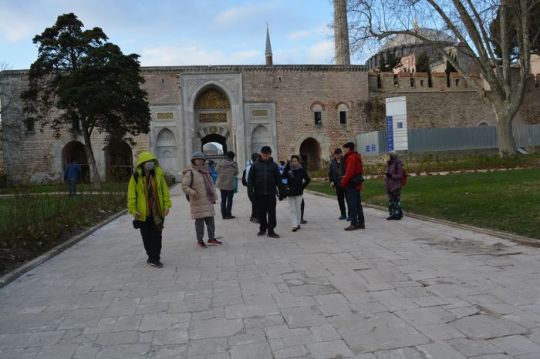
Devingrad Tracing Centuries of Civilization
Origin and Evolution
Devingrad, also known as “Momina Krepost,” lies east of Tsaravets, its name evolving from ancient Thracian origins through Byzantium to its present-day nomenclature under Ottoman rule. Through meticulous research, the mist of time surrounding this ancient site has begun to clear, revealing a rich tapestry of civilization dating back to the end of the Bronze Age and the dawn of the Iron Age around 1300 B.C.
Thracian Heritage
Early evidence, including rudimentary fences and structures, offers glimpses into ancient habitation patterns, with artifacts from hunting, cooking, and pottery production dating back to the Iron Age. The zenith of Thracian society around 500-400 B.C. is marked by strong cultural ties to Greek civilization, evidenced by the widespread use of classic Greek amphorae.
Byzantine Connections
The Byzantine era leaves its mark on Devingrad through the remains of fortress walls, basilicas, and domestic architecture reminiscent of the ancient city of Sikidava. Destroyed around 700 A.D., Sikidava’s influence persisted into the early 9th century A.D., coinciding with the spread of the First Bulgarian Kingdom as evidenced by archaeological findings Private Turkey Tours.
Rise to Prominence
The 11th and 12th centuries witness Devingrad’s population growth and transformation into a secure urban center, eventually evolving into a capital city from 1186 to 1393. This transition catalyzed a surge in commercial activity, fostering prosperity, trade, and artistic craftsmanship. Notably, Turnovo became renowned as a cultural hub, attracting artists, writers, and intellectuals who contributed to its vibrant identity.
Cultural Renaissance
The city’s distinctive style flourished, giving rise to identifiable schools of art and architecture that bear the hallmark of Turnovo’s unique heritage. From meticulously crafted precious metals to intricate artworks, Turnovo’s artisans and merchants thrived, solidifying its reputation as a beacon of cultural and economic prosperity.
Devingrad’s journey through time unveils a captivating narrative of human ingenuity, resilience, and cultural innovation. From its humble beginnings in antiquity to its zenith as a bustling capital city, Devingrad’s legacy endures as a testament to Bulgaria’s rich historical heritage and enduring spirit of creativity.
0 notes
Text
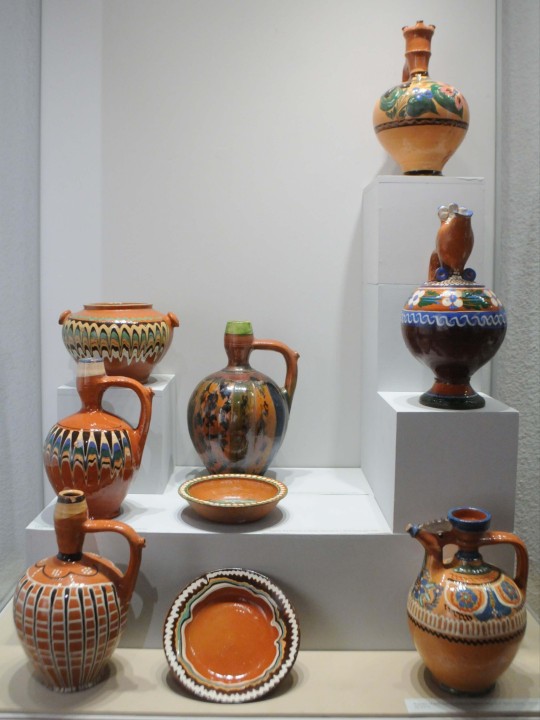
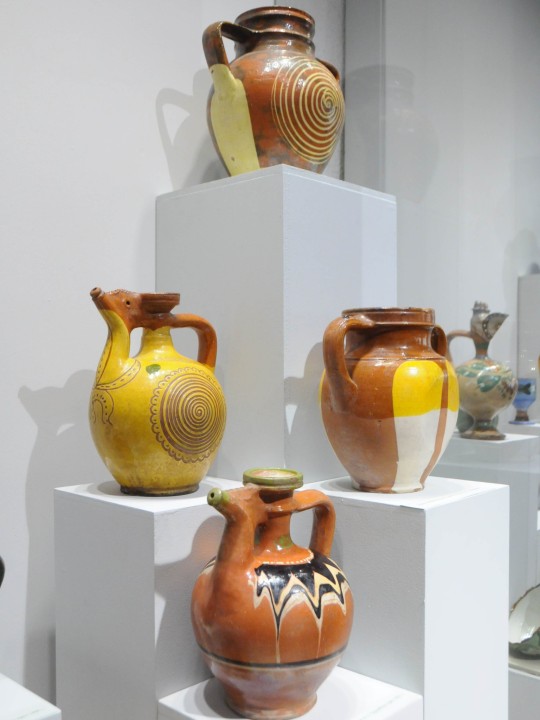
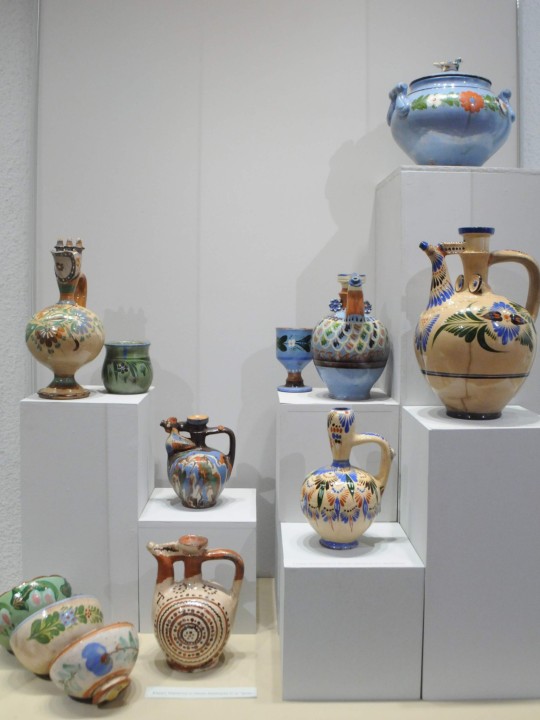

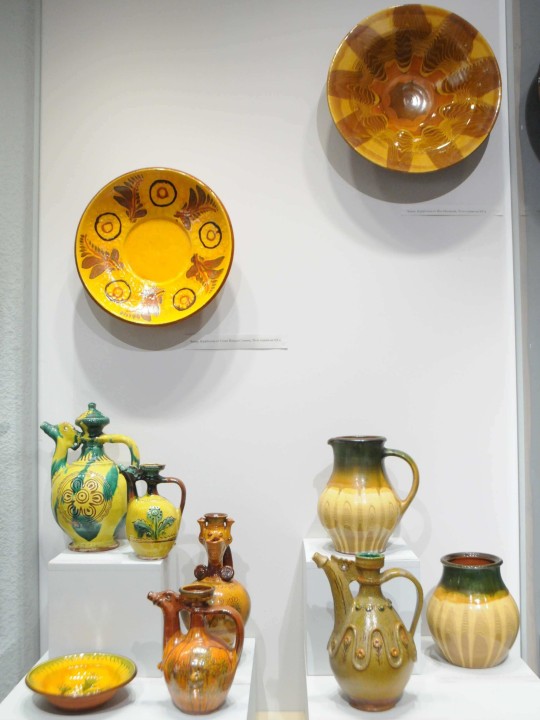
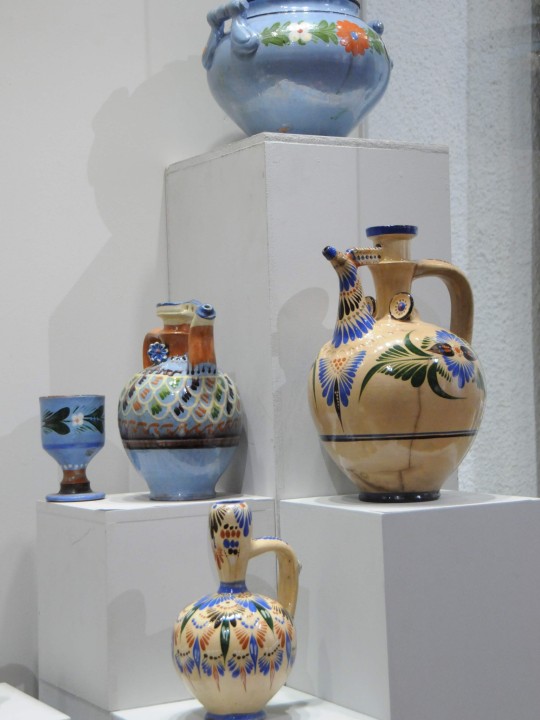
Troyan Pottery
Troyan Museum of National Crafts and Applied Arts
(19th century to the late 20th century)
Troyan, Bulgaria
Troyan pottery is the most recognisable and widely practiced form of pottery in Bulgaria today.
One of the first mentions of a potter's guild in Troyan is from 1852. The craft developed rapidly following Bulgarian Liberation, with the first secondary school for pottery being founded in Troyan 1911. By the middle of the 20th century, the Troyan school of pottery takes shape. Its style is very distinctive and it incorporates old motifs while adapting them to contemporary tastes.
The photos above are from an exhibition titled The Wealth of Troyan Pottery which presents works from the 19th century to the 1970s. It includes works by some of the most famous masters of the craft - Dancho Vasileshki, Nikola Nikolski, Tsocho Kovachev, Bayu Dobrev and Petar Tsankov. It tells the story of the Iovkovi family, who were craftsmen who carried the art across four generations, and Iova Raevska - one of the most important masters who helped develop the art of ceramics in Bulgaria.
#Bulgaria#bulgarian pottery#Ceramics#Bulgarian ceramics#Eastern european ceramics#Eastern European pottery#The Bulgarian Pottery series
79 notes
·
View notes
Photo
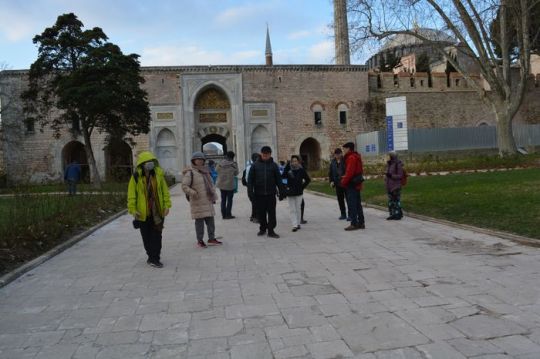
Devingrad Tracing Centuries of Civilization
Origin and Evolution
Devingrad, also known as “Momina Krepost,” lies east of Tsaravets, its name evolving from ancient Thracian origins through Byzantium to its present-day nomenclature under Ottoman rule. Through meticulous research, the mist of time surrounding this ancient site has begun to clear, revealing a rich tapestry of civilization dating back to the end of the Bronze Age and the dawn of the Iron Age around 1300 B.C.
Thracian Heritage
Early evidence, including rudimentary fences and structures, offers glimpses into ancient habitation patterns, with artifacts from hunting, cooking, and pottery production dating back to the Iron Age. The zenith of Thracian society around 500-400 B.C. is marked by strong cultural ties to Greek civilization, evidenced by the widespread use of classic Greek amphorae.
Byzantine Connections
The Byzantine era leaves its mark on Devingrad through the remains of fortress walls, basilicas, and domestic architecture reminiscent of the ancient city of Sikidava. Destroyed around 700 A.D., Sikidava’s influence persisted into the early 9th century A.D., coinciding with the spread of the First Bulgarian Kingdom as evidenced by archaeological findings Private Turkey Tours.
Rise to Prominence
The 11th and 12th centuries witness Devingrad’s population growth and transformation into a secure urban center, eventually evolving into a capital city from 1186 to 1393. This transition catalyzed a surge in commercial activity, fostering prosperity, trade, and artistic craftsmanship. Notably, Turnovo became renowned as a cultural hub, attracting artists, writers, and intellectuals who contributed to its vibrant identity.
Cultural Renaissance
The city’s distinctive style flourished, giving rise to identifiable schools of art and architecture that bear the hallmark of Turnovo’s unique heritage. From meticulously crafted precious metals to intricate artworks, Turnovo’s artisans and merchants thrived, solidifying its reputation as a beacon of cultural and economic prosperity.
Devingrad’s journey through time unveils a captivating narrative of human ingenuity, resilience, and cultural innovation. From its humble beginnings in antiquity to its zenith as a bustling capital city, Devingrad’s legacy endures as a testament to Bulgaria’s rich historical heritage and enduring spirit of creativity.
0 notes
Text
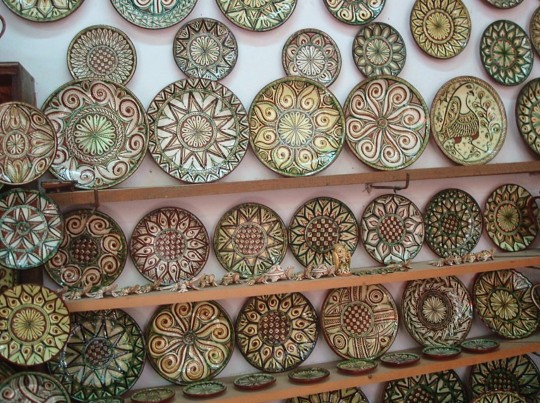


Mother and son ceramic artists — Nina and Dimitar Neshevi, handcrafting sgraffito pottery at their workshop on the market street (Samovodska Charshiya) of the old Bulgarian capital, Veliko Tarnovo.
Майка и син майстори грънчари — Нина и Димитър Нешеви, изработват на ръка сграфито керамика в занаятчийската си работилница на Самоводската чаршия, Велико Търново.
(source)
2 notes
·
View notes
Photo
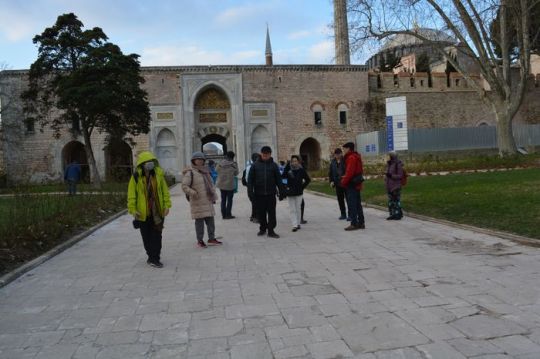
Devingrad Tracing Centuries of Civilization
Origin and Evolution
Devingrad, also known as “Momina Krepost,” lies east of Tsaravets, its name evolving from ancient Thracian origins through Byzantium to its present-day nomenclature under Ottoman rule. Through meticulous research, the mist of time surrounding this ancient site has begun to clear, revealing a rich tapestry of civilization dating back to the end of the Bronze Age and the dawn of the Iron Age around 1300 B.C.
Thracian Heritage
Early evidence, including rudimentary fences and structures, offers glimpses into ancient habitation patterns, with artifacts from hunting, cooking, and pottery production dating back to the Iron Age. The zenith of Thracian society around 500-400 B.C. is marked by strong cultural ties to Greek civilization, evidenced by the widespread use of classic Greek amphorae.
Byzantine Connections
The Byzantine era leaves its mark on Devingrad through the remains of fortress walls, basilicas, and domestic architecture reminiscent of the ancient city of Sikidava. Destroyed around 700 A.D., Sikidava’s influence persisted into the early 9th century A.D., coinciding with the spread of the First Bulgarian Kingdom as evidenced by archaeological findings Private Turkey Tours.
Rise to Prominence
The 11th and 12th centuries witness Devingrad’s population growth and transformation into a secure urban center, eventually evolving into a capital city from 1186 to 1393. This transition catalyzed a surge in commercial activity, fostering prosperity, trade, and artistic craftsmanship. Notably, Turnovo became renowned as a cultural hub, attracting artists, writers, and intellectuals who contributed to its vibrant identity.
Cultural Renaissance
The city’s distinctive style flourished, giving rise to identifiable schools of art and architecture that bear the hallmark of Turnovo’s unique heritage. From meticulously crafted precious metals to intricate artworks, Turnovo’s artisans and merchants thrived, solidifying its reputation as a beacon of cultural and economic prosperity.
Devingrad’s journey through time unveils a captivating narrative of human ingenuity, resilience, and cultural innovation. From its humble beginnings in antiquity to its zenith as a bustling capital city, Devingrad’s legacy endures as a testament to Bulgaria’s rich historical heritage and enduring spirit of creativity.
0 notes
Photo
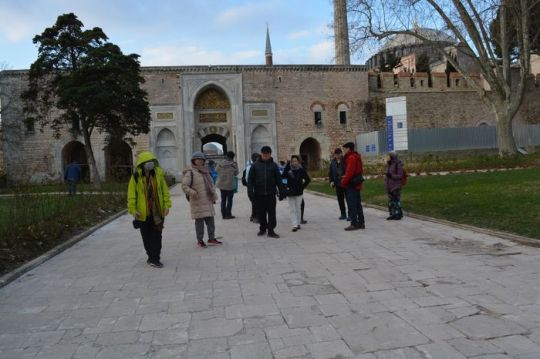
Devingrad Tracing Centuries of Civilization
Origin and Evolution
Devingrad, also known as “Momina Krepost,” lies east of Tsaravets, its name evolving from ancient Thracian origins through Byzantium to its present-day nomenclature under Ottoman rule. Through meticulous research, the mist of time surrounding this ancient site has begun to clear, revealing a rich tapestry of civilization dating back to the end of the Bronze Age and the dawn of the Iron Age around 1300 B.C.
Thracian Heritage
Early evidence, including rudimentary fences and structures, offers glimpses into ancient habitation patterns, with artifacts from hunting, cooking, and pottery production dating back to the Iron Age. The zenith of Thracian society around 500-400 B.C. is marked by strong cultural ties to Greek civilization, evidenced by the widespread use of classic Greek amphorae.
Byzantine Connections
The Byzantine era leaves its mark on Devingrad through the remains of fortress walls, basilicas, and domestic architecture reminiscent of the ancient city of Sikidava. Destroyed around 700 A.D., Sikidava’s influence persisted into the early 9th century A.D., coinciding with the spread of the First Bulgarian Kingdom as evidenced by archaeological findings Private Turkey Tours.
Rise to Prominence
The 11th and 12th centuries witness Devingrad’s population growth and transformation into a secure urban center, eventually evolving into a capital city from 1186 to 1393. This transition catalyzed a surge in commercial activity, fostering prosperity, trade, and artistic craftsmanship. Notably, Turnovo became renowned as a cultural hub, attracting artists, writers, and intellectuals who contributed to its vibrant identity.
Cultural Renaissance
The city’s distinctive style flourished, giving rise to identifiable schools of art and architecture that bear the hallmark of Turnovo’s unique heritage. From meticulously crafted precious metals to intricate artworks, Turnovo’s artisans and merchants thrived, solidifying its reputation as a beacon of cultural and economic prosperity.
Devingrad’s journey through time unveils a captivating narrative of human ingenuity, resilience, and cultural innovation. From its humble beginnings in antiquity to its zenith as a bustling capital city, Devingrad’s legacy endures as a testament to Bulgaria’s rich historical heritage and enduring spirit of creativity.
0 notes
Photo

Devingrad Tracing Centuries of Civilization
Origin and Evolution
Devingrad, also known as “Momina Krepost,” lies east of Tsaravets, its name evolving from ancient Thracian origins through Byzantium to its present-day nomenclature under Ottoman rule. Through meticulous research, the mist of time surrounding this ancient site has begun to clear, revealing a rich tapestry of civilization dating back to the end of the Bronze Age and the dawn of the Iron Age around 1300 B.C.
Thracian Heritage
Early evidence, including rudimentary fences and structures, offers glimpses into ancient habitation patterns, with artifacts from hunting, cooking, and pottery production dating back to the Iron Age. The zenith of Thracian society around 500-400 B.C. is marked by strong cultural ties to Greek civilization, evidenced by the widespread use of classic Greek amphorae.
Byzantine Connections
The Byzantine era leaves its mark on Devingrad through the remains of fortress walls, basilicas, and domestic architecture reminiscent of the ancient city of Sikidava. Destroyed around 700 A.D., Sikidava’s influence persisted into the early 9th century A.D., coinciding with the spread of the First Bulgarian Kingdom as evidenced by archaeological findings Private Turkey Tours.
Rise to Prominence
The 11th and 12th centuries witness Devingrad’s population growth and transformation into a secure urban center, eventually evolving into a capital city from 1186 to 1393. This transition catalyzed a surge in commercial activity, fostering prosperity, trade, and artistic craftsmanship. Notably, Turnovo became renowned as a cultural hub, attracting artists, writers, and intellectuals who contributed to its vibrant identity.
Cultural Renaissance
The city’s distinctive style flourished, giving rise to identifiable schools of art and architecture that bear the hallmark of Turnovo’s unique heritage. From meticulously crafted precious metals to intricate artworks, Turnovo’s artisans and merchants thrived, solidifying its reputation as a beacon of cultural and economic prosperity.
Devingrad’s journey through time unveils a captivating narrative of human ingenuity, resilience, and cultural innovation. From its humble beginnings in antiquity to its zenith as a bustling capital city, Devingrad’s legacy endures as a testament to Bulgaria’s rich historical heritage and enduring spirit of creativity.
0 notes